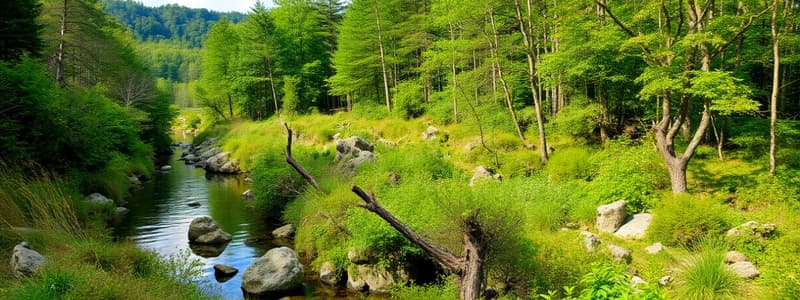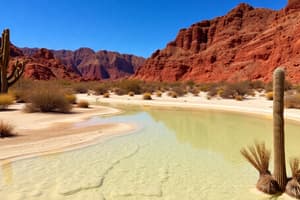Podcast
Questions and Answers
What primarily categorizes terrestrial biomes?
What primarily categorizes terrestrial biomes?
- Dominant forms of plant life (correct)
- Geographical location
- Animal population density
- Types of soil in the region
Which factor is most directly responsible for the long-term climate of a region?
Which factor is most directly responsible for the long-term climate of a region?
- Local wildlife activity
- Latitude and altitude (correct)
- Daily weather changes
- Seasonal temperature shifts
Where are tropical rainforests typically found?
Where are tropical rainforests typically found?
- On continental ice sheets
- In mountainous regions
- Near the equator (correct)
- Around the Arctic Circle
What is a notable characteristic of the climate in tropical rainforests?
What is a notable characteristic of the climate in tropical rainforests?
How do ocean currents affect climate?
How do ocean currents affect climate?
What adaptation helps desert plants conserve water?
What adaptation helps desert plants conserve water?
Which animal adaptation is common in savanna animals for avoiding drought?
Which animal adaptation is common in savanna animals for avoiding drought?
What is a characteristic of freshwater biomes?
What is a characteristic of freshwater biomes?
What is one of the main threats to coral reefs?
What is one of the main threats to coral reefs?
Which type of biomes primarily has four distinct seasons?
Which type of biomes primarily has four distinct seasons?
What influences the types of plants and animals that can thrive in a biome?
What influences the types of plants and animals that can thrive in a biome?
Which factor causes temperatures to generally decrease as one moves towards the poles?
Which factor causes temperatures to generally decrease as one moves towards the poles?
What is the typical climate of tropical rainforests?
What is the typical climate of tropical rainforests?
Which of the following is NOT a characteristic of the climate in biomes?
Which of the following is NOT a characteristic of the climate in biomes?
Which of the following statements accurately describes the vegetation in tropical rainforests?
Which of the following statements accurately describes the vegetation in tropical rainforests?
What adaptation is common in plants of the savanna to access water during dry periods?
What adaptation is common in plants of the savanna to access water during dry periods?
Which of the following animals is least likely to be found in a tundra biome?
Which of the following animals is least likely to be found in a tundra biome?
What is a characteristic feature of desert plants that helps them survive?
What is a characteristic feature of desert plants that helps them survive?
In which biome would you typically find deciduous trees?
In which biome would you typically find deciduous trees?
What adaptation do many marine organisms have for dealing with high salinity levels?
What adaptation do many marine organisms have for dealing with high salinity levels?
Flashcards are hidden until you start studying
Study Notes
Introduction to Biomes
- Biomes are large-scale ecosystems with similar climate, soil, plants and animals.
- Biomes are categorized into terrestrial (land) and aquatic (water) types.
- Climate determines the type of biome that can exist in a region.
Climate
- Climate is the long-term pattern of weather conditions, including temperature, humidity, wind, and precipitation.
- Factors influencing climate include latitude, altitude, ocean currents, wind patterns, and proximity to water.
Terrestrial Biomes
- Tropical Rainforest:
- Found near the equator with warm and wet conditions year-round.
- Characterized by dense vegetation with a high diversity of plant and animal species.
- Plants have large leaves to capture sunlight and drip tips to shed excess water.
- Animals like monkeys and birds are adapted to life in trees.
- Savanna:
- Found in Africa, South America, and Australia, with warm temperatures and seasonal rainfall.
- Dominated by grasses with scattered trees and shrubs.
- Plants are drought-resistant and adapted to fire.
- Large herbivores like elephants and predators like lions are common.
- Desert:
- Found in areas with extremely low rainfall and hot days and cold nights.
- Sparse vegetation, dominated by water-storing cacti and other drought-resistant plants.
- Animals are adapted to conserve water and avoid the intense heat.
- Temperate Forest:
- Found in North America, Europe, and Asia, with four distinct seasons and moderate rainfall.
- Dominated by deciduous trees that shed their leaves in winter.
- Animals may hibernate or migrate during the winter.
- Tundra:
- Found in Arctic regions and on high mountains, with cold and dry conditions and a short growing season.
- Low-growing plants, including mosses, lichens, and dwarf shrubs.
- Animals have thick fur or fat layers to survive cold temperatures.
- Grassland:
- Found in North America, South America, and Eurasia, with moderate rainfall and distinct seasons.
- Dominated by grasses with few trees.
- Animals include large herbivores and predators.
Aquatic Biomes
- Freshwater Biomes:
- Includes lakes, rivers, streams, and wetlands.
- Low salinity (less than 1% salt content).
- Plants and animals adapted to low-salt environments.
- Marine Biomes:
- Includes oceans, coral reefs, and estuaries.
- High salinity (around 3.5% salt content).
- Diverse range of plants and animals adapted to high-salinity conditions.
Coral Reefs
- Coral reefs are unique marine biomes with high biodiversity, found in shallow, warm waters.
- Built by coral polyps.
- Highly sensitive to changes in temperature, acidity, and pollution.
Climate Change and Biomes
- Climate change is affecting biomes through warming temperatures, changing precipitation patterns, and rising sea levels.
- Biomes may shift in location, or experience changes in vegetation and animal populations as a result of climate change.
Introduction to Biomes
- Biomes are large regions with similar climate, soil, plants, and animals.
- Biomes help understand life distribution and ecosystem functions.
- Biomes are categorized into terrestrial (land) and aquatic (water) types.
- Climate is the key factor determining a biome, influencing plant and animal life.
Climate
- Climate refers to long-term weather patterns in a region.
- Factors influencing climate:
- Latitude: Warmer near the equator, colder towards the poles.
- Altitude: Higher altitudes are cooler.
- Ocean currents: Distribute heat globally, impacting coastal temperatures.
- Wind patterns: Carry moisture and heat, affecting rainfall and dryness.
- Proximity to water: Large bodies of water moderate climate, leading to milder temperatures and humidity.
Terrestrial Biomes
- Classified based on dominant plant life and adaptations to climate.
Tropical Rainforest
- Location: Near the equator (South America, Africa, Southeast Asia, Australia).
- Climate: Warm and wet year-round, with temperatures between 20°C and 25°C.
- Vegetation: Dense with tall trees forming a canopy, high biodiversity.
- Animals: Diverse, including insects, birds, mammals, and reptiles, many adapted to tree life.
- Adaptations: Plants have large leaves for sunlight capture and drip tips for water shedding. Animals adapted for tree dwelling or dense undergrowth.
Savanna
- Location: Found in Africa, South America, and Australia.
- Climate: Warm with seasonal rainfall, dry seasons lasting several months.
- Vegetation: Dominated by grasses with scattered trees and shrubs, drought-resistant plants.
- Animals: Large herbivores (elephants, zebras, giraffes), predators (lions, hyenas).
- Adaptations: Plants have deep roots for water access and thick bark for fire resistance. Animals may migrate or have adaptations for running in open spaces.
Desert
- Location: North Africa (Sahara), Middle East, Australia, southwestern United States.
- Climate: Extremely dry, less than 25 cm of rainfall per year, hot days and cold nights.
- Vegetation: Sparse, with cacti storing water and having spines instead of leaves.
- Animals: Reptiles, rodents, and insects adapted to conserve water and stay cool. Many are nocturnal.
- Adaptations: Plants have extensive root systems and dormancy during dry periods. Animals have water-conserving behaviors and physical traits to avoid heat.
Temperate Forest
- Location: North America, Europe, Asia.
- Climate: Four distinct seasons with moderate rainfall (75 to 150 cm per year).
- Vegetation: Deciduous trees dominate, with some coniferous trees in some regions.
- Animals: Deer, bears, birds, and insects, many hibernate or migrate in winter.
- Adaptations: Deciduous trees shed leaves in winter for water conservation, while conifers have needle-like leaves to reduce water loss. Animals hibernate, migrate, or have thick fur for cold winters.
Tundra
- Location: Arctic and high altitudes on mountains.
- Climate: Cold and dry, with temperatures often below freezing, short growing seasons.
- Vegetation: Mostly low-growing plants like mosses, lichens, and dwarf shrubs.
- Animals: Animals adapted to cold, like caribou, arctic foxes, and polar bears, many birds migrate.
- Adaptations: Tundra plants grow low to avoid cold winds and have dark colors for heat absorption. Animals have thick fur, fat layers, or migratory behaviors.
Grassland
- Location: North America (prairies), South America (pampas), Eurasia (steppes).
- Climate: Moderate rainfall (25 to 75 cm per year) with distinct seasons, hot summers and cold winters.
- Vegetation: Dominated by grasses with few trees, fertile soil ideal for agriculture.
- Animals: Large herbivores (bison, antelope), predators (wolves, coyotes).
- Adaptations: Grassland plants have deep roots for fire and drought survival. Animals are often fast runners or live in burrows for protection.
Aquatic Biomes
- Classified by physical and chemical characteristics of water: salinity, depth, and flow.
- Two main types: freshwater and marine.
Freshwater Biomes
- Types: Rivers, lakes, streams, and wetlands.
- Salinity: Low, less than 1% salt content.
- Vegetation: Algae, floating plants, rooted plants like water lilies, wetlands have grasses and trees.
- Animals: Fish, amphibians, insects, birds, and microorganisms.
- Adaptations: Plants and animals adapted to low-salt environments, fish have specialized kidneys, plants have flexible stems.
Marine Biomes
- Types: Oceans, coral reefs, and estuaries.
- Salinity: High, around 3.5% salt content.
- Vegetation: Algae, seaweeds, and seagrasses, coral reefs have diverse plant life.
- Animals: Vast range of species, from plankton to whales, coral reefs have high biodiversity.
- Adaptations: Marine organisms have specialized glands for salt excretion, fish have streamlined bodies, adaptations to temperature and light.
Coral Reefs
- Unique marine biomes with high biodiversity.
- Found in shallow, warm waters, built by coral polyps.
- Support a vast array of life, including fish, mollusks, and crustaceans.
- Highly sensitive to changes in temperature, acidity, and pollution.
Threats to Coral Reefs
- Climate change: Rising sea temperatures cause coral bleaching, leading to reef death.
- Overfishing: Depletes fish populations that are vital for coral reef ecosystems.
- Pollution: Runoff from land contaminates coral reefs and negatively impacts coral health.
Climate and Biomes
- Climate is the primary factor determining biome distribution and characteristics.
- Climate changes lead to shifts in biomes, impacting plant and animal life.
Climate Change and Biomes
- Climate change caused by human activities impacts biomes:
- Warming temperatures: Biomes shift towards the poles or higher altitudes. Tundra regions shrink, temperate forests move northward.
- Changing precipitation patterns: Droughts and flooding affect water availability, altering vegetation and wildlife.
- Sea level rise: Threatens coastal biomes like mangroves, estuaries, and coral reefs.
Studying That Suits You
Use AI to generate personalized quizzes and flashcards to suit your learning preferences.




